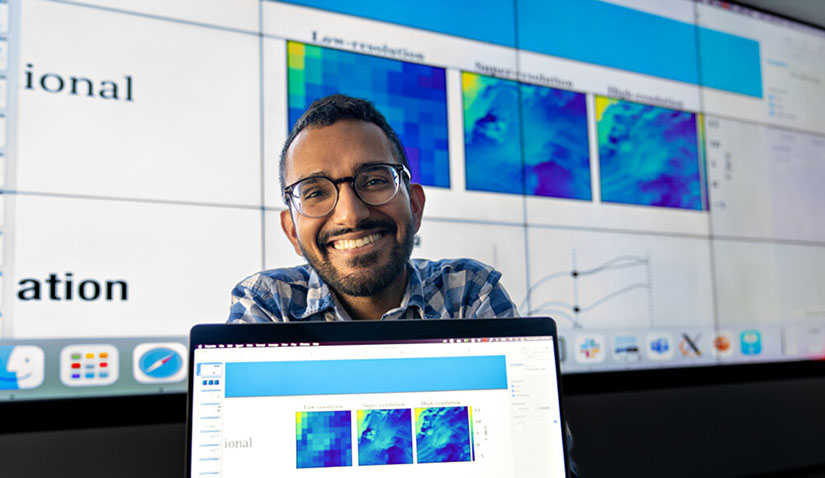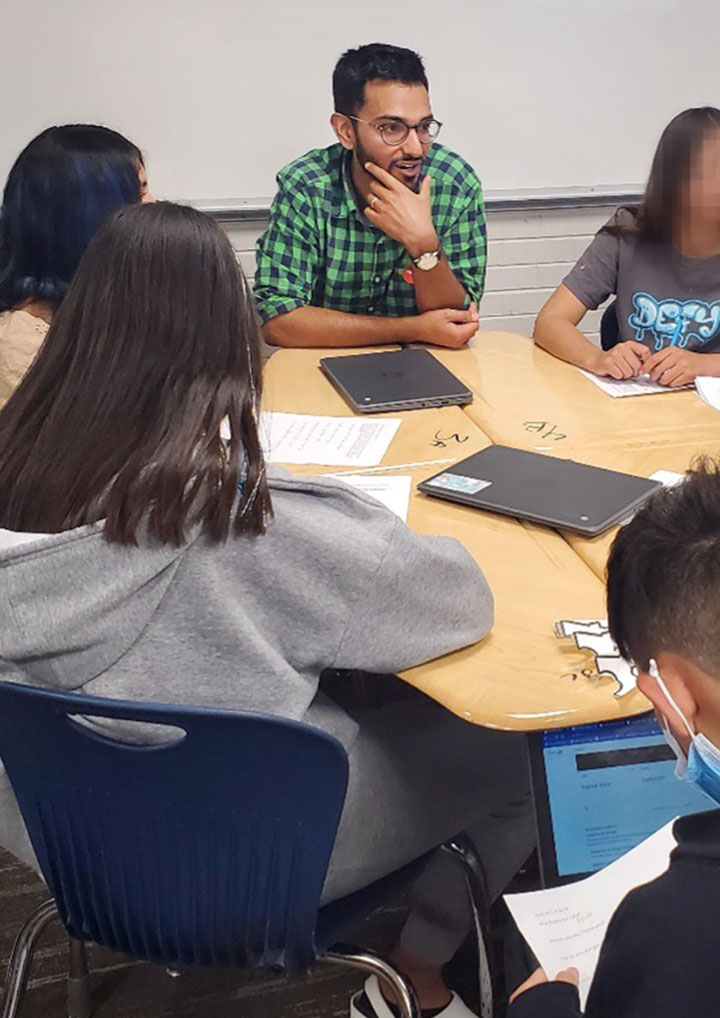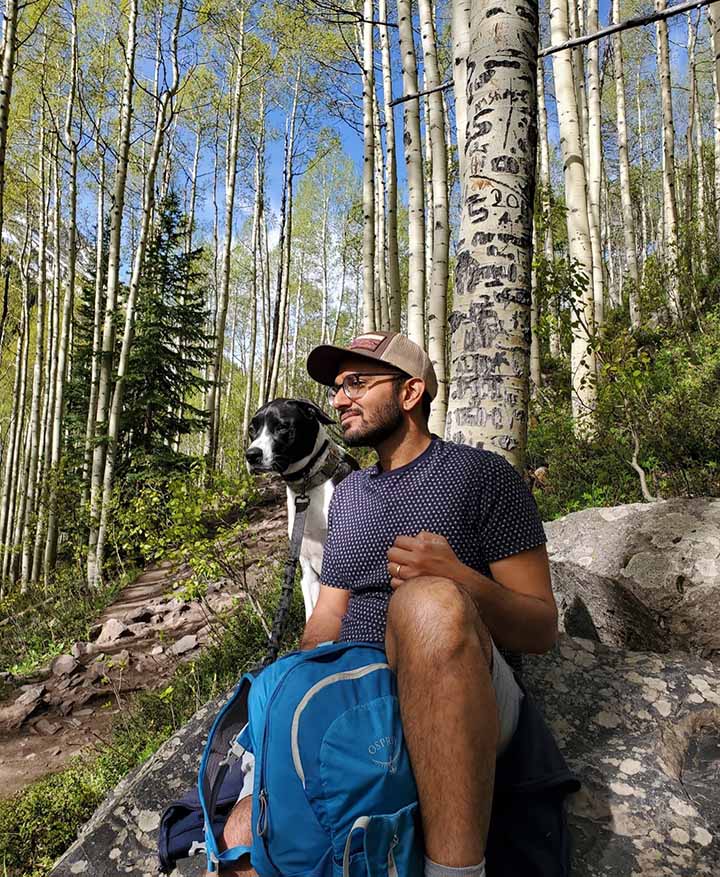Making the Uncertain (More) Certain: How Malik Hassanaly Approaches the Invitation to Wonder

Anyone who has spent time with children knows the common refrain: Why? Kids' curiosity blooms from the desire to understand the always new and surprising world around them. That wonder is something that we sometimes lose as adults.
Wonder sticks with scientists and researchers, too—especially for Malik Hassanaly, National Renewable Energy Laboratory (NREL) computational science researcher, whose work in uncertainty quantification, machine learning, and computational fluid dynamics pushes him to wonder, "Why? What if? Why do we do this in the first place?"
Hassanaly sees this sense of uncertainty as an opportunity—a space for discovery. "My nieces and nephews ask fundamental questions, and those questions remind me that I maybe don't know everything or haven't thought about something thoroughly," he said. That unknown leads to wonder, which leads to action.

In the book "Hope in the Dark," Rebecca Solnit writes that inside the space of uncertainty is room to act. As someone who is inclined to wonder, Hassanaly searches for the spaces in science that open room for exploration.
One way that Hassanaly works to address "why" is through uncertainty quantification, using computational science tools to characterize and estimate uncertainties in computational and real-world applications. His work essentially addresses confidence—the more you can understand uncertainty, the better you can address it. When you decide to install a wind turbine based on the energy you expect to produce, it helps to know how confident you are in your estimate of energy production, he said.
"We're trying to know what we don't know," Hassanaly said.
Uncertainty quantification for real-world applications typically requires estimating the effect of many uncertainty sources on many variables.
"For instance, if you are estimating a detailed wind field based on scattered observations, the observations may contain thousands of variables, while the detailed wind field may contain millions of variables," Hassanaly said. "The question is: How do you manipulate these high-dimensional spaces in a tractable way?"
Optimizing Approaches to Complex Problems
Hassanaly's work on uncertainty happens in and outside the office. He had an idea: Why not develop an algorithm to optimize guest seating at his wedding.
"I created a tool, which uses a matchmaking method similar to dating apps, to optimize my seating chart. Here, our guests have some level of affinity with each other, which is subject to some level of uncertainty," Hassanaly said. "The tool tries to find an optimal seating chart that maximizes the affinity of guests at each table. This turned out to be useful to quickly adapt to COVID-related cancellations. It was also a great way to perfect some skills I use at NREL."
Approaching complex problems by creating simpler methods is sort of his thing. When he is brought into a project, he looks for assumptions that can be made to simplify the overall problem.
"How can I represent the problem differently, in a way that is more friendly to our computational methods?" he asks. "And, though we might lose some of the initial complexity, we can now obtain solutions there were out of reach and that help us understand the original problem."
Hassanaly brings this approach to existing work, trying to locate an opportunity to alter or redefine problems to allow breakthroughs to happen. For example, he has worked on building neural networks able to generate many possible detailed wind fields given coarse observations. The generated wind fields are samples drawn from a high-dimensional distribution that is unknown. Instead of completely characterizing this distribution, which is not possible, he ensured that some key properties of this distribution, that can be computed, are recovered by the samples generated.
"The same method can also apply to remote sensing, data assimilation, other coarse-grained models (such as large eddy simulations), and rare event probability estimation," Hassanaly said.
His computational science work spans many different research areas such as solar energy, wind energy, bioenergy, energy storage, and cybersecurity. He has also contributed to Pele—the open-source software codes suite that simulates low Mach and compressible reacting flows—and projects that utilize Pele codes.
Hassanaly questions methods and assumptions. That can be uncomfortable, but that is how he likes it.
"I like that feeling of discomfort and having to learn a lot with a new topic," he said.
Working on topics he is not familiar with might help him think of familiar problems differently or might allow him to bring a perspective to a new problem that other researchers benefit from.
Making Science Accessible
Hassanaly was obsessed with motorsports from a young age—he is fascinated with the sports' engineering and driving aspects.
"I always wanted to be a Formula 1 driver, but that didn't pan out, so I hoped to become an F1 engineer and ended up finding my place here [at NREL]," he said. "From the engineering side, teams need to constantly revisit their designs and ask, 'Why?' They need to make choices under time and budget constraints in an uncertain environment, whether it be during the design process or during a race. To me, this is very similar to what we do at NREL."

Science, like motorsports, requires accepting risk and embracing the unknown. Those things may inspire fear or doubt, and people can be cautious about scientific innovations until they have a chance to experience them in the real world.
Scientific advances do not happen in a vacuum—they need application in the real-world to have an impact. Hassanaly said that technological advances alone will not "make the cut" to tackle climate change because you have to make them available and approachable to people and communities.
"How do energy choices affect society in general? Are they in accordance with peoples' values? I think about these things a lot," he said.
Gaining support for and acceptance of energy technologies might start with understanding people's needs and desires. Hassanaly is interested in how people who are different from him think about climate, community, and values. He wants to know how they came to their opinions and how we can meet them where they are to find a way forward in energy transition that makes sense.
"We have heard a lot recently from people resistant to wind energy, for instance," he said. "What's causing that resistance? Is it something we can address? I think you can learn from that. I think the solution to climate change is not just about scientific innovation—it is also about how societal and economic changes will be implemented to either allow people to benefit from scientific advances or to prevent economic practices that adversely affect global warming. Implementing change isn't trivial—it requires the same level of innovation as tackling technical challenges."
Outreach and understanding are key to implementation.
"So, I think about how you make science available to people to improve their lives," he said. "I think we can meet people where they are and make the energy transition work for everyone."
Hassanaly works across NREL to provide computational science support to complex energy research. Learn more about how NREL's Computational Science Center helps transform energy systems. Learn more about Hassanaly's interests and work.
Last Updated May 28, 2025
